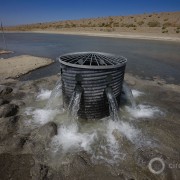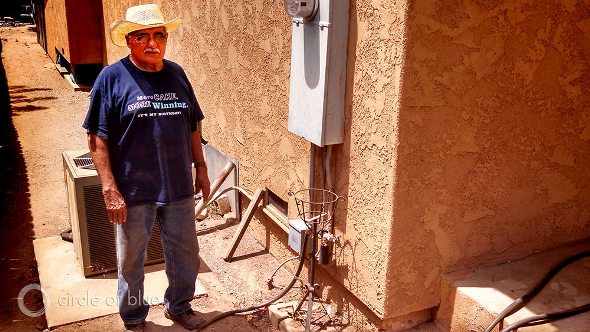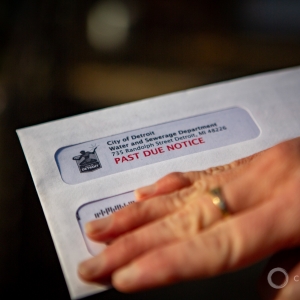EPA Revises Rules for Lead in Drinking Water
EPA strengthens some provisions but does not take the bigger step of requiring replacement of all lead service lines.

A sign above a bathroom sink in Flint, Michigan, from February 6, 2016, instructs people not to drink the water because of high lead levels. Photo © J. Carl Ganter/Circle of Blue
By Brett Walton, Circle of Blue
The U.S. Environmental Protection Agency completed its first major revisions in nearly three decades to federal rules for lead in drinking water, adding a raft of new intricacies to one of the country’s most complex drinking water regulations.
Andrew Wheeler, the EPA administrator, called the revisions “the capstone” of the Trump administration’s efforts to address lead contamination, arguing that the goal is to protect children, reduce lead, and empower communities with more information about sources of lead in their water.
Water policy experts offered a more muted appraisal of the rule, acknowledging progress in some areas but pointing out serious flaws in the overall approach.
Elin Betanzo, founder of the consulting firm Safe Water Engineering, said that the rule is an improvement in some aspects — requiring sampling protocols that will be more adept at lead detection and ordering utilities to produce an inventory of lead service lines — but it falls short in key areas. Though there are provisions for utilities to replace lead pipes, the mandate is weaker than it could be, she said.
“It isn’t doing the most important thing for reducing exposure to lead in drinking water, and that’s removing lead pipes,” Betanzo told Circle of Blue.
The EPA estimates that there are 6.1 million to 10 million lead service lines in the country, and health experts say that any amount of lead can harm brain development in infants and children. Service lines connect water mains to household plumbing.
Much of the criticism of the EPA rule has been directed at changes to the timeline for replacing lead service lines. The previous rule required utilities with more than 10 percent of their water samples testing above 15 parts per billion for lead — a threshold called the “action level” — to replace 7 percent of their lead service lines per year. Utilities could stop the replacements once lead levels dropped below the action level for two consecutive six-month monitoring periods.
The result was that few lead service line replacements were completed, said Betanzo, a former EPA staff member who later helped uncover the lead crisis in Flint. Utilities could dodge the requirement by testing water from homes that were unlikely to have lead pipes.
The new rule adjusts the numbers in this calculus. It cuts the pipe replacement requirement from 7 percent per year to 3 percent per year. Utilities have to continue that replacement schedule for a minimum of two years before they can opt out if their testing shows that lead levels are below the action level. Water samples must be taken from homes that have lead service lines.
Partial replacements, in which only the utility-owned portion of the service line is replaced, no longer count toward the requirement. Partial replacements can cause lead levels in household drinking water to spike.
Why not keep the 7-percent requirement and eliminate some of the loopholes that weakened it? Wheeler said that water utilities “have finite resources” and many water quality and infrastructure needs. The agency wanted them to have the financial resources to address other problems, he said.
“We, as a regulatory agency, can never just focus on one pollutant,” Wheeler said.
Basket of New Requirements
The rule’s reach goes much farther than pipe replacement timelines. The agency added new requirements for taking water samples, testing water in schools, and notifying customers about lead issues. The rule requires utilities to take action at individual homes where lead is detected during testing. It also introduces a “trigger level” of 10 parts per billion that initiates heightened monitoring and water treatment to prevent pipe corrosion.
“This rule is about interrelated actions, not a single number,” said Jennifer McClain, director of the EPA Office of Ground Water and Drinking Water.
A potentially helpful change is the sampling protocol, Betanzo said. Instead of sampling the first liter of water that comes from the tap, which was the previous method, utilities will capture the fifth liter. Water from deeper in the plumbing system is more likely to be in contact with lead service lines.
Betanzo said that the state of Michigan requires utilities to capture both the first and the fifth liter and take the higher of the two measures. Two-thirds of the samples in Michigan had the highest lead readings in the fifth liter. Mandating this change nationwide could result in more lead being detected, but a comprehensive approach would include the first liter as well, she said.
In addition to testing protocol changes, utilities will be required to complete an inventory of the location of lead service lines within three years. A Government Accountability Office report published last week identified the characteristics of neighborhoods that are more likely to have lead pipes: those neighborhoods are poorer and the homes are older.
Sri Vedachalam, water program director at the Environmental Policy Innovation Center, said that the inventory is the rule’s most beneficial component.
“By itself, this is a driver for pipe replacement,” Vedachalam told Circle of Blue. “More disclosure leads to more public pressure.”
Utilities will also be required to test drinking water in 20 percent of elementary schools and childcare facilities each year. Though this will provide more information about drinking water quality in these buildings, it also forces utilities to establish new relationships and expand the reach of their testing programs.
All told, the changes add significant new responsibilities for water utilities. Betanzo worries that new requirements could be overwhelming.
“I’m very concerned that the added complexity of this rule outweighs the benefits,” said Betanzo. “But we won’t know that until we start implementing it.”
Administrative burdens on small water systems, which account for the majority of community water systems, are a particular concern of the National Rural Water Association.
“Enhancing drinking water and wastewater quality in small communities is more of a resource than a regulatory problem,” NRWA wrote in comments to the EPA on the draft version of the rule.
When resources — funding, by and large — are available, much progress can be made. After about $120 million in state and federal funding, lead pipe replacement in Flint is nearly complete. Vedachalam pointed to Wisconsin’s use of federal funds to finance lead pipe replacement. But, he cautioned, most of the success stories are in large cities, not in small towns.
Betanzo said that knowing which requirements under the new rule apply at any given time will be a challenge. Not only for utilities, which will be taking on new sampling and testing mandates as well as infrastructure inventories, but also for regulators. The staff of state and federal oversight agencies will need to keep vigilant about the status of each water system. If they don’t, then errors might be made, she said.
“Water systems might fall through the cracks,” Betanzo added. “And when they fall through the cracks is when lead crises happen.”
Brett writes about agriculture, energy, infrastructure, and the politics and economics of water in the United States. He also writes the Federal Water Tap, Circle of Blue’s weekly digest of U.S. government water news. He is the winner of two Society of Environmental Journalists reporting awards, one of the top honors in American environmental journalism: first place for explanatory reporting for a series on septic system pollution in the United States(2016) and third place for beat reporting in a small market (2014). He received the Sierra Club’s Distinguished Service Award in 2018. Brett lives in Seattle, where he hikes the mountains and bakes pies. Contact Brett Walton












Leave a Reply
Want to join the discussion?Feel free to contribute!